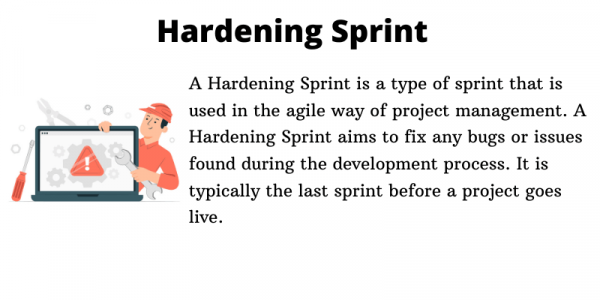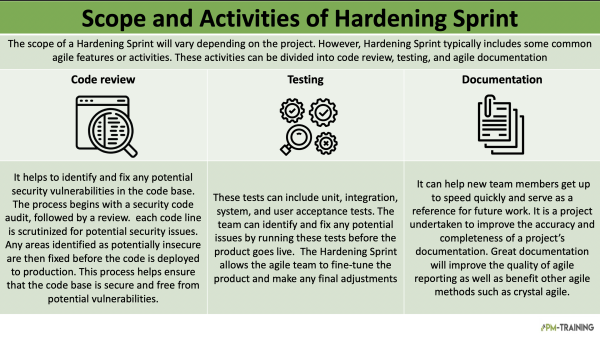Hardening Sprint is an integral part of the Agile Framework. It is a time-boxed event, usually lasting between one and four weeks, in which an agile collaboration happens with a team to deliver potentially shippable product increments. A Hardening Sprint is a particular type of sprint that helps you prepare your software for release. This blog post will discuss what Hardening Sprint is and how you can use it to improve your project management process.
A Hardening Sprint is a type of sprint that is used in the agile way of project management. A Hardening Sprint aims to fix any bugs or issues found during the development process. It is typically the last sprint before a project goes live.

Scope and Activities of Hardening Sprint
The scope of a Hardening Sprint will vary depending on the project. However, Hardening Sprint typically includes some common agile features or activities. These activities can be divided into code review, testing, and agile documentation.
Code review
Code review is an essential part of the Hardening Sprint. It helps to identify and fix any potential security vulnerabilities in the code base. The process begins with a security code audit, followed by a review.
During the code review, each code line is scrutinized for potential security issues. Any areas identified as potentially insecure are then fixed before the code is deployed to production. This process helps ensure that the code base is secure and free from potential vulnerabilities.

Testing
The main goal of the Hardening Sprint is to ensure that all of the product’s features and functionality are working as expected. The team conducts a series of tests on the product to do this.
These tests can include unit, integration, system, and user acceptance tests. The team can identify and fix any potential issues by running these tests before the product goes live.
In addition, the Hardening Sprint allows the agile team to fine-tune the product and make any final adjustments. As a result, the Hardening Sprint is essential to ensuring that a product is ready for launch.

Documentation
Documentation is an essential part of any project, as it can help new team members get up to speed quickly and serve as a reference for future work. It is a project undertaken to improve the accuracy and completeness of a project’s documentation.
It typically involves identifying areas where the documentation is lacking, writing or revising existing documentation, and conducting reviews to ensure it is clear and accurate. Great documentation will improve the quality of agile reporting as well as benefit other agile methods such as crystal agile.
This type of sprint can be challenging, but it can also be very rewarding, as it can lead to a better understanding of the project and improved communication within the team.

When to Use Hardening Sprint
As a general rule, consider using a Hardening Sprint whenever you plan significant changes or additions to the product.
For example, if you’re adding a new feature or making changes to an existing feature, you’ll want to consider using a Hardening sprint to ensure that everything works as expected. In addition, if you’re planning to release a new product version, you should also use a Hardening Sprint to verify that all new features are working correctly before release.
By taking these extra steps at the end of your agile project, you can ensure that your product is ready for release and avoid any last-minute surprises.
Benefits of Hardening Sprint
A Hardening Sprint is a term used in the Agile working model. It is a sprint focused on fixing bugs and other issues before releasing the software to production. While this may seem like a waste of time, there are several benefits to making a Hardening Sprint:
- It helps to ensure that the software is of high quality. By taking the time to fix bugs and other issues before release, you can help to avoid problems later on.
- It can help to improve communication between developers and testers. Working together to identify and fix problems can ensure everyone is on the same page.
- It can help to build trust between the development team and stakeholders as well as foster an agile team culture.
By showing that you are willing to invest time and effort into fixing issues before release, you can demonstrate your commitment to delivering a high-quality product.
Alternatives of Hardening Sprint
If a Hardening Sprint is not possible or practical, you can use some alternatives.
Soft Launch
One alternative is to use a soft launch instead of a full launch. With a soft launch, you can launch a project but only make it available to a limited number of users. With soft launching, features are gradually rolled out to a small group of users, with the goal being to receive feedback and identify any issues before rolling out the features to the entire user base.
This approach can help to reduce the risk of problems during launch while also giving stakeholders an early opportunity to provide feedback. As a result, soft launching is an increasingly popular alternative to sprint hardening.
Beta Testing
One of the most critical aspects of agile engineering is testing. To ensure that a new program or app meets all the requirements, it needs to be put through its paces by a group of dedicated testers. This process, known as beta testing, allows developers to catch any bugs or issues before the product is released to the general public.
However, beta testing can be time-consuming and expensive. That’s why most teams opt for using Hardening Sprints.
Hardening sprints are vital to the success of any Agile project. They help ensure that the product is high quality and ready for launch. You can use Hardening sprints whenever there are major changes or additions and when a new version is released.
You can also opt for alternatives such as soft launches and beta testing if a Hardening Sprint is not possible or practical. Taking these steps can help to ensure that the project is successful and can even help to build trust between stakeholders and developers.
By taking the time to make a Hardening Sprint, you can rest assured that your project will be ready for launch.
